2019 VOLKSWAGEN TRANSPORTER transmission
[x] Cancel search: transmissionPage 33 of 486

Before the journey
Before setting off
Driving tips
CO Introduction
This chapter contains information on the following subjects:
Preparing for a journey and driving safely
Driving abroad ...................... .
Driving through water on roads ........ .
33 34
35
An engine and transmission guard may prove use-ful, depending on the conditions in which the vehi-cle is to be driven. An engine and transmission guard can reduce the risk of damage to the vehi-cle's underbody and engine oil sump, for example when driving over kerbs, driveways or unsurfaced roads. Volkswagen Commercial Vehicles recom-mends using a Volkswagen Commercial Vehicles dealership for this purpose.
Additional Information and warnings:
• Sitting correctly and safely 61
• Transporting 125
• Starting the engine, changing gear and parking the vehicle 257
• Driving with respect for the environment =>page 278
• Consumer information 404
A WARNING
Driving under the Influence of alcohol, drugs, medication or narcotics can cause serious accidents and fatal Injuries.
• Alcohol, drugs, medication and narcotics can severely impair perception, reaction times and driving safety. This could cause you to lose control of the vehicle.
l""""('n First read and observe the Introductory L-Wl Information and safety warnings th on page 33.
Checklist
Observe the following Information both before and during the journey to ensure your own safety and the safety of passengers and other road users
..( Check that all lights and turn signals are working properly.
Check the tyre pressure 367 and fuel level 340.
..( Ensure that you have a good, clear view through all of the windows.
..( Air intake to the engine must not be obstruc-ted, and the engine must not be covered with any kind of insulating materials th in ell Introduction on page 351.
0::
g!
..(
..(
..(
..(
..(
..(
..(
Secure any objects and luggage in the stowage compartments, the luggage corn-partment or on the roof 125 .
Ensure that you are able to operate the ped-als freely at all times .
Secure any children travelling in the vehicle in a restraint system suitable for their weight and size =>page 96.
Adjust the front seats, head restraints and mirrors properly in accordance with the size of the occupants 61.
Wear shoes that provide good grip for your feet when using the pedals.
The floor mat in the footwell on the driver side must leave the pedal area free and must be securely fastened .
Assume a correct sitting position before set-ling off and maintain this position while driv-ing. This also applies to all passengers =>page 61. ..
Before setting off 33
Page 264 of 486
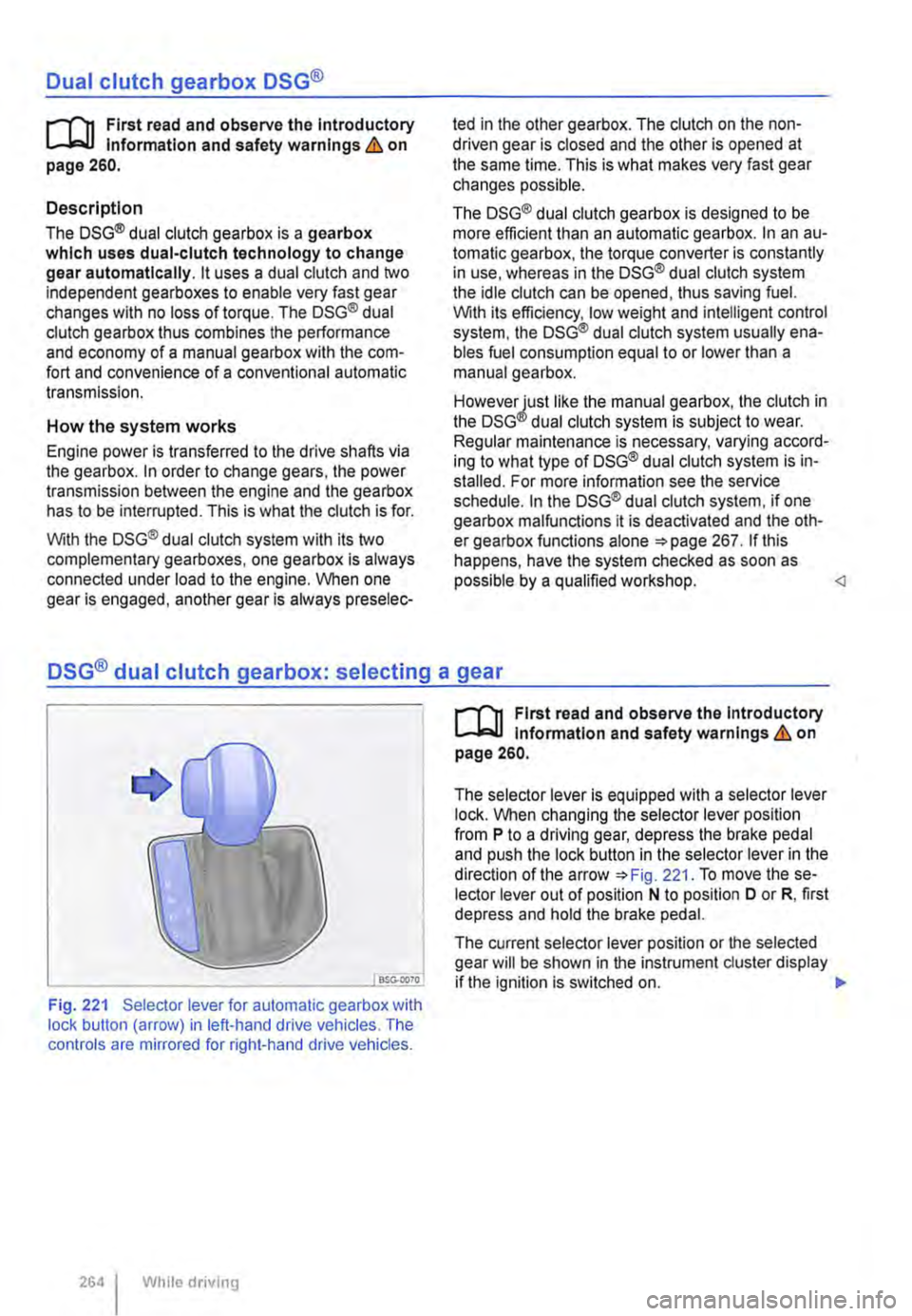
Dual clutch gearbox DSG®
r-('n First read and observe the Introductory L-.lo:on Information and safety warnings & on page 260.
Description
The DSG® dual clutch gearbox is a gearbox which uses dual-clutch technology to change gear automatically. it uses a dual clutch and two independent gearboxes to enable very fast gear changes with no loss of torque. The DSG® dual clutch gearbox thus combines the performance and economy of a manual gearbox with the com-fort and convenience of a conventional automatic transmission.
How the system works
Engine power is transferred to the drive shafts via the gearbox. In order to change gears, the power transmission between the engine and the gearbox has to be interrupted. This is what the clutch is for.
With the DSG® dual clutch system with its two complementary gearboxes, one gearbox is always connected under load to the engine. When one gear is engaged, another gear is always preselec-
led in the other gearbox. The clutch on the non-driven gear is closed and the other is opened at the same time. This is what makes very fast gear changes possible.
The DSG® dual clutch gearbox is designed to be more efficient than an automatic gearbox. In an au-tomatic gearbox, the torque converter is constantly in use, whereas in the DSG® dual clutch system the idle clutch can be opened, thus saving fuel. With its efficiency, low weight and intelligent control system, the DSG® dual clutch system usually ena-bles fuel consumption equal to or lower than a manual gearbox.
like the manual gearbox, the clutch in the DSG dual clutch system is subject to wear. Regular maintenance is necessary, varying accord-ing to what type of DSG® dual clutch system is in-stalled. For more information see the service schedule. In the DSG® dual clutch system, if one gearbox malfunctions it is deactivated and the oth-er gearbox functions alone *page 267. If this happens, have the system checked as soon as possible by a qualified workshop.
Fig. 221 Selector lever for automatic gearbox with lock button (arrow) in left-hand drive vehicles. The controls are mirrored for right-hand drive vehicles.
264 I While driving
r-('n First read and observe the Introductory L-.lo:on Information and safety warnings & on page 260.
The selector lever is equipped with a selector lever lock. When changing the selector lever position from P to a driving gear, depress the brake pedal and push the lock button in the selector lever in the direction of the arrow *Fig. 221. To move the se-lector lever out of position N to position D or R, first depress and hold the brake pedal.
The current selector lever position or the selected gear will be shown in the instrument duster display if the ignition is switched on. .,..
Page 265 of 486
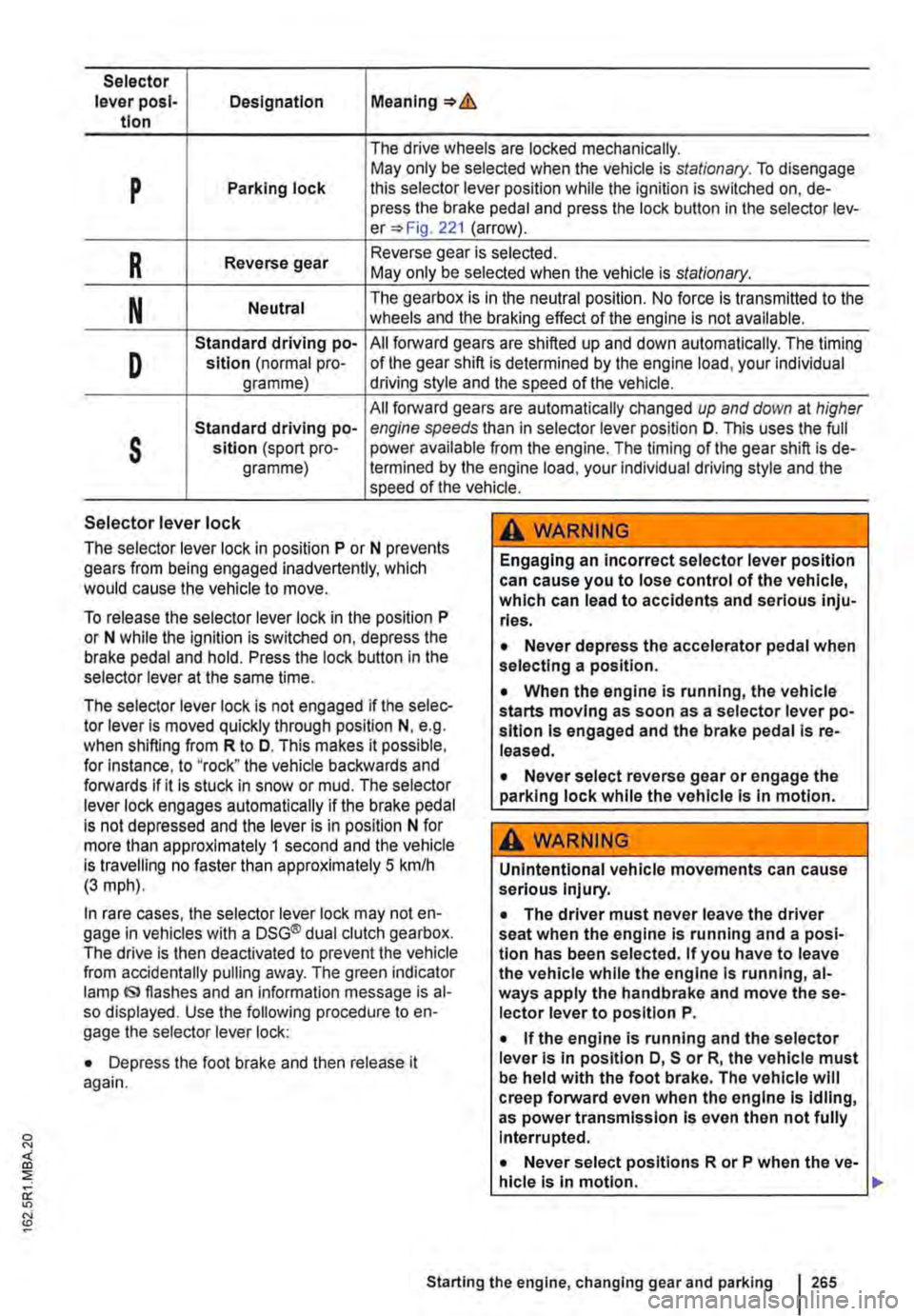
Selector lever posl-Designation Meaning=>& tlon
The drive wheels are locked mechanically.
p May only be selected when the vehicle is stationary. To disengage Parking lock this selector lever position while the ignition is switched on, de-press the brake pedal and press the lock button in the selector lev-er=> Fig. 221 (arrow).
R Reverse gear Reverse gear is selected. May only be selected when the vehicle is stationary.
N Neutral The gearbox is in the neutral position. No force is transmitted to the wheels and the braking effect of the engine is not available.
D
Standard driving po-All forward gears are shifted up and down automatically. The timing sition (normal pro-of the gear shift is determined by the engine load, your individual gramme) driving style and the speed of the vehicle.
All forward gears are automatically changed up and down at higher
s
Standard driving po-engine speeds than in selector lever position D. This uses the full sltlon (sport pro-power available from the engine. The timing of the gear shift is de-gramme) !ermined by the engine load, your individual driving style and the speed of the vehicle.
Selector lever lock
The selector lever lock in position P or N prevents gears from being engaged inadvertently, which would cause the vehicle to move.
To release the selector lever lock in the position P or N while the ignition is switched on, depress the brake pedal and hold. Press the lock button in the selector lever at the same time.
The selector lever lock is not engaged if the selec-tor lever Is moved quickly through position N, e.g. when shifting from R to D. This makes it possible, for Instance, to "rock" the vehicle backwards and forwards if it is stuck in snow or mud. The selector lever lock engages automatically if the brake pedal is not depressed and the lever is in position N for more than approximately 1 second and the vehicle is travelling no faster than approximately 5 km/h (3 mph).
In rare cases, the selector lever lock may not en-gage in vehicles with a DSG® dual clutch gearbox. The drive is then deactivated to prevent the vehicle from accidentally pulling away. The green indicator lamp IS> flashes and an information message is al-so displayed. Use the following procedure to en-gage the selector lever lock:
• Depress the foot brake and then release it again.
,A WARNING
Engaging an incorrect selector lever position can cause you to lose control of the vehicle, which can lead to accidents and serious inju-ries.
• Never depress the accelerator pedal when selecting a position.
• When the engine is running, the vehicle starts moving as soon as a selector lever po-sition is engaged and the brake pedal Is re-leased.
• Never select reverse gear or engage the parking lock while the vehicle Is In motion.
A WARNING
Unintentional vehicle movements can cause serious Injury.
• The driver must never leave the driver seat when the engine is running and a posi-tion has been selected. If you have to leave the vehicle while the engine Is running, al-ways apply the handbrake and move the se-lector lever to position P.
• If the engine is running and the selector lever Is in position D, S or R, the vehicle must be held with the foot brake. The vehicle will creep forward even when the engine Is idling, as power transmission Is even then not fully Interrupted.
• Never select positions R or P when the ve-hicle is In motion.
Starting the engine, changing gear and parking 265
Page 287 of 486

ParkPilot
o:n Introduction
This chapter contains information on the following subjects:
ParkPilot only at rear . . 288 ParkPilot front and rear . . . 289
ParkPilot signal tones and displays . 290
The Park Pilot assists the driver when
parking and manoeuvring.
The ultrasound sensors in the bumpers transmit and receive ultrasound waves. The electronic sys-tem uses the ultrasound waves (i.e. transmission, reflection from the obstacle and reception) to cal-culate the distance between the bumper and the obstacle.
Additional information and warnings:
• Exterior views =:o page 5
• Braking, stopping and parking =:o page 269
• Reversing camera (Rear Assist) =:o page 291
• Cleaning and caring for the vehicle exterior =:.page 380
• Accessories, modifications, repairs and renewal of parts =:o page 394
• Radio or navigation system =:o Booklet Radio, provision for mobile telephone, infotainment sys-tem, navigation system
A WARNING
ParkPilot technology cannot overcome sys-tem-related vehicle limitations. The ParkPilot cannot replace the full concentration of the driver.
• Unintentional vehicle movements can cause serious injury.
• Always adapt your speed and driving style to suit visibility, weather, road and traffic con-ditions.
• Ultrasound sensors have blind spots in which obstacles and people cannot be detec-ted.
• Always check the area around the vehicle as the ultrasound sensors will not always de-tect infants, animals and objects.
A WARNING (Continued)
• Certain surfaces of objects and clothes cannot reflect the signals from the ultrasound sensors. The system is unable to detect these objects or people wearing this type of clothing, or they may be detected incorrectly.
• External sources of sound can affect the signals of the ultrasound sensors. This may prevent the system from recognising people or objects.
CD
Various factors can negatively Impact the Park-Pilot functions or lead to damage to the vehicle and objects in the area surrounding the vehi-cle.
• The ultrasound sensors may not always be able to detect objects such as trailer drawbars, thin rails, fences, posts, trees and open or opening boot lids. This can result in damage to your vehicle.
• If the ParkPilot has detected an obstacle and issued a warning, the obstacle may move out of the detection range of the ultrasound sensors as the vehicle approaches it, particu-larly if the object is very high or very low. These objects are no longer registered.
• The vehicle can sustain considerable dam-age if the warning given by the ParkPiiot is ig-nored.
• Ultrasound sensors can be displaced or damaged through Impacts, e.g. when parking.
• The ultrasound sensors must be kept clean and free of ice and snow, and must not be cov-ered up by stickers or other objects, as this will prevent the system from working properly.
• Repainting the ultrasound sensors can im-pair the function of the Park Pilot.
• The ultrasound sensors should only be sprayed briefly when cleaning with pressure hoses and steam cleaners. The steam/hose nozzle must always be kept more than 10 cm away from the ultrasound sensors.
• Sources of noise can lead to errors in the ParkPilot system, e.g. rough asphalt, cobble-stones, induction loops, building equipment, or interference from other vehicles.
Driver assist systems 287
Page 398 of 486
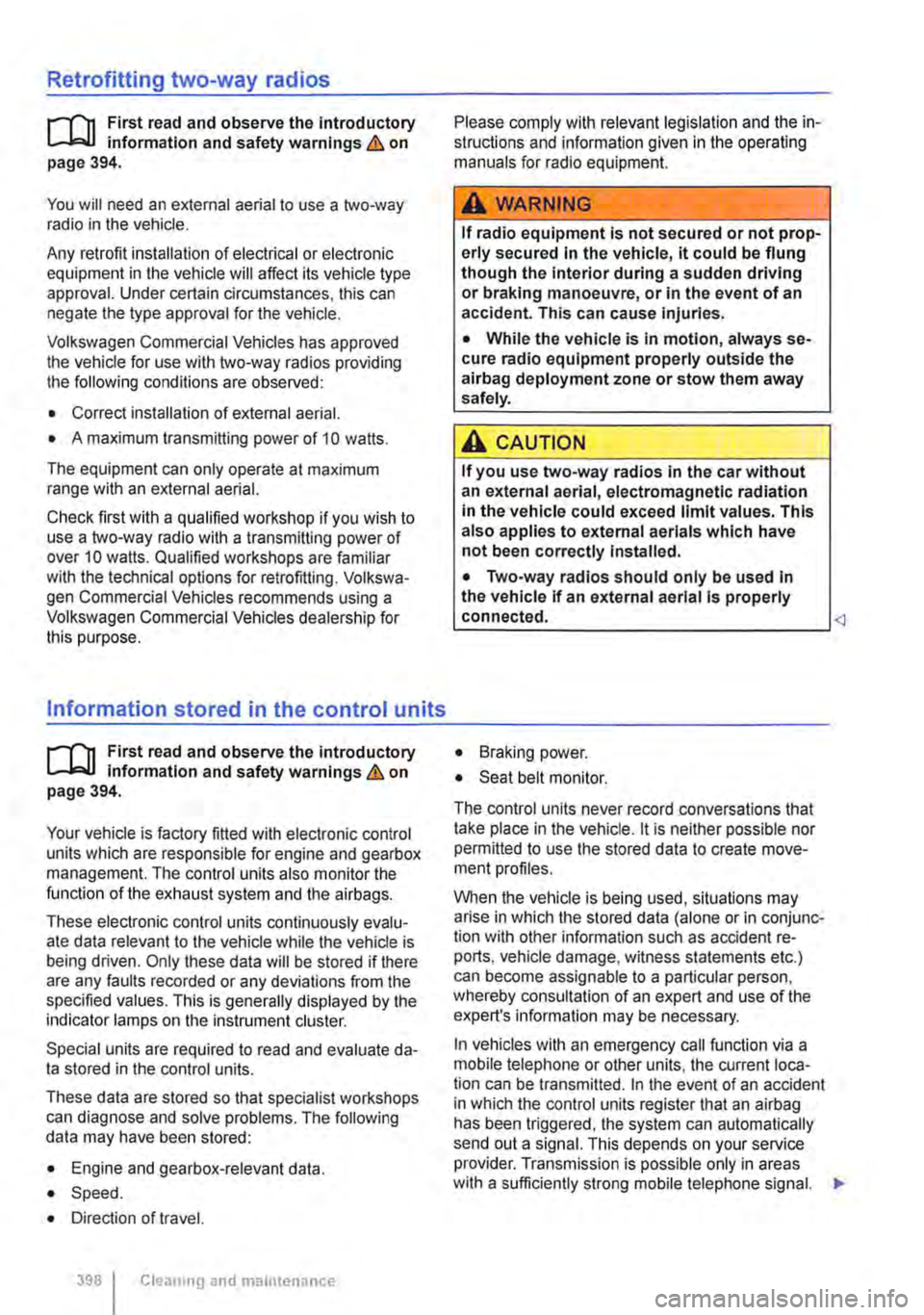
Retrofitting two-way radios
.--m First read and observe the introductory L-.lc.U information and safety warnings & on page 394.
You will need an external aerial to use a two-way radio in the vehicle.
Any retrofit installation of electrical or electronic equipment in the vehicle will affect its vehicle type approval. Under certain circumstances, this can negate the type approval for the vehicle.
Volkswagen Commercial Vehicles has approved the vehicle for use with two-way radios providing the following conditions are observed:
• Correct installation of external aerial.
• A maximum transmitting power of 10 watts.
The equipment can only operate at maximum range with an external aerial.
Check first with a qualified workshop if you wish to use a two-way radio with a transmitting power of over 10 watts. Qualified workshops are familiar with the technical options for retrofitting. Volkswa-gen Commercial Vehicles recommends using a Volkswagen Commercial Vehicles dealership for this purpose.
Information stored in the control units
.--m First read and observe the introductory L-.lc.U Information and safety warnings & on page 394.
Your vehicle is factory fitted with electronic control units which are responsible for engine and gearbox management. The control units also monitor the function of the exhaust system and the airbags.
These electronic control units continuously evalu-ate data relevant to the vehicle while the vehicle is being driven. Only these data will be stored if there are any faults recorded or any deviations from the specified values. This is generally displayed by the indicator lamps on the instrument cluster.
Special units are required to read and evaluate da-ta stored in the control units.
These data are stored so that specialist workshops can diagnose and solve problems. The following data may have been stored:
• Engine and gearbox-relevant data.
• Speed.
• Direction of travel.
398 Cleaning and maintenance
Please comply with relevant legislation and the in-structions and information given in the operating manuals for radio equipment.
A WARNING
If radio equipment is not secured or not prop-erly secured in the vehicle, it could be flung though the interior during a sudden driving or braking manoeuvre, or In the event of an accident. This can cause Injuries.
• While the vehicle is in motion, always se-cure radio equipment properly outside the airbag deployment zone or stow them away safely.
A CAUTION
If you use two-way radios in the car without an external aerial, electromagnetic radiation in the vehicle could exceed limit values. This also applies to external aerials which have not been correctly installed.
• Two-way radios should only be used In the vehicle If an external aerial Is properly connected.
• Braking power.
• Seat belt monitor.
The control units never record conversations that take place in the vehicle. it is neither possible nor permitted to use the stored data to create move-ment profiles.
When the vehicle is being used, situations may arise in which the stored data (alone or in conjunc-tion with other information such as accident re-ports, vehicle damage, witness statements etc.) can become assignable to a particular person, whereby consultation of an expert and use of the expert's information may be necessary.
In vehicles with an emergency call function via a mobile telephone or other units, the current loca-tion can be transmitted. In the event of an accident in which the control units register that an airbag has been triggered, the system can automatically send out a signal. This depends on your service provider. Transmission is possible only in areas
Page 403 of 486
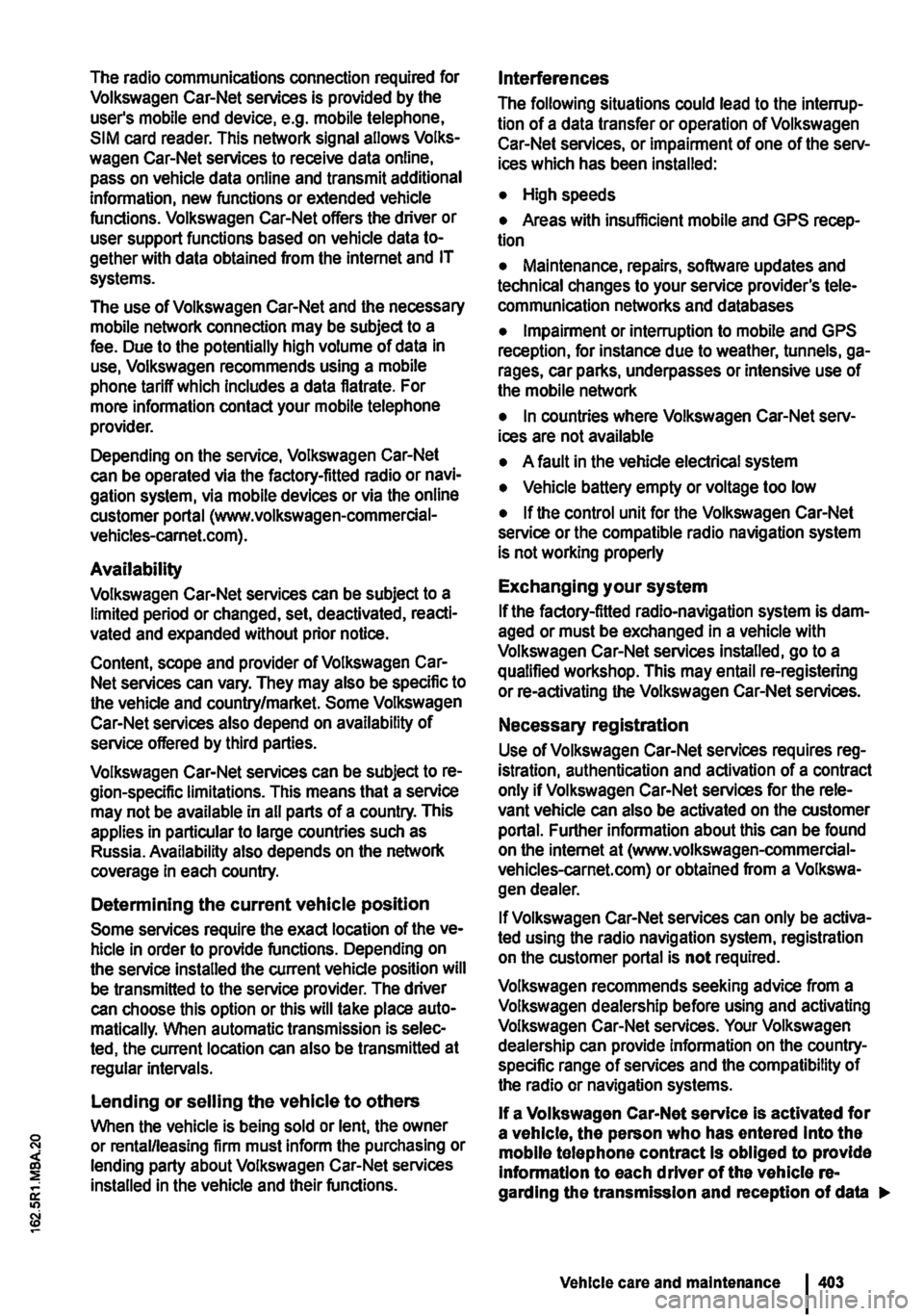
The radio communications connection required for Volkswagen Car-Net services is provided by the user's mobile end device, e.g. mobile telephone, SIM card reader. This network signal allows Volks-wagen Car-Net services to receive data online, pass on vehicle data online and transmit additional information, new functions or extended vehicle functions. Volkswagen Car-Net offers the driver or user support functions based on vehicle data to-gether with data obtained from the Internet and IT systems.
The use of Volkswagen Car-Net and the necessary mobile network connection may be subject to a fee. Due to the potentially high volume of data in use, Volkswagen recommends using a mobile phone tariff which includes a data flatrate. For more information contact your mobile telephone provider.
Depending on the service, Volkswagen Car-Net can be operated via the factory-fitted radio or navi-gation system, via mobile devices or via the online customer portal (www.volkswagen-commercial-vehicles-camet.com).
Availability
Volkswagen Car-Net services can be subject to a limited period or changed, set, deactivated, reacti-vated and expanded without prior notice.
Content, scope and provider of Volkswagen Car-Net services can vary. They may also be specific to the vehicle and country/market. Some Volkswagen Car-Net services also depend on availability of service offered by third parties.
Volkswagen Car-Net services can be subject to re-gion-specific limitations. This means that a service may not be available in all parts of a country. This applies in particular to large countries such as Russia. Availability also depends on the network coverage in each country.
Determining the current vehicle position
Some services require the exact location of the ve-hicle in order to provide functions. Depending on the service installed the current vehicle position will be transmitted to the service provider. The driver can choose this option or this will take place auto-matically. When automatic transmission is selec-ted, the current location can also be transmitted at regular intervals.
Lending or selling the vehicle to others
When the vehicle is being sold or lent, the owner or rentaUieasing firm must inform the purchasing or lending party about Volkswagen Car-Net services installed in the vehicle and their functions.
Interferences
The following situations could lead to the interrup-tion of a data transfer or operation of Volkswagen Car-Net services, or impairment of one of the serv-ices which has been installed:
• High speeds
• Areas with insufficient mobile and GPS recep-tion
• Maintenance, repairs, software updates and technical changes to your service provider's tele-communication networks and databases
• Impairment or interruption to mobile and GPS reception, for instance due to weather, tunnels, ga-rages, car parks, underpasses or intensive use of the mobile network
• In countries where Volkswagen Car-Net serv-ices are not available
• A fault in the vehicle electrical system
• Vehicle battery empty or voltage too low
• If the control unit for the Volkswagen Car-Net service or the compatible radio navigation system is not working properly
Exchanging your system
If the factory-fitted radio-navigation system is dam-aged or must be exchanged in a vehicle with Volkswagen Car-Net services installed, go to a qualified workshop. This may entail re-registering or re-activating the Volkswagen Car-Net services.
Necessary registration
Use of Volkswagen Car-Net services requires reg-istration, authentication and activation of a contract only if Volkswagen Car-Net services for the rele-vant vehicle can also be activated on the customer portal. Further information about this can be found on the Internet at (www.volkswagen-commercial-vehicles-carnet.com) or obtained from a Volkswa-gen dealer.
If Volkswagen Car-Net services can only be activa-ted using the radio navigation system, registration on the customer portal is not required.
Volkswagen recommends seeking advice from a Volkswagen dealership before using and activating Volkswagen Car-Net services. Your Volkswagen dealership can provide information on the country-specific range of services and the compatibility of the radio or navigation systems.
If a Volkswagen Car-Net service is activated for a vehicle, the person who has entered Into the mobile telephone contract Is obliged to provide information to each driver of the vehicle re-garding the transmission and reception of data .-
Vehicle care and maintenance 1403
Page 404 of 486
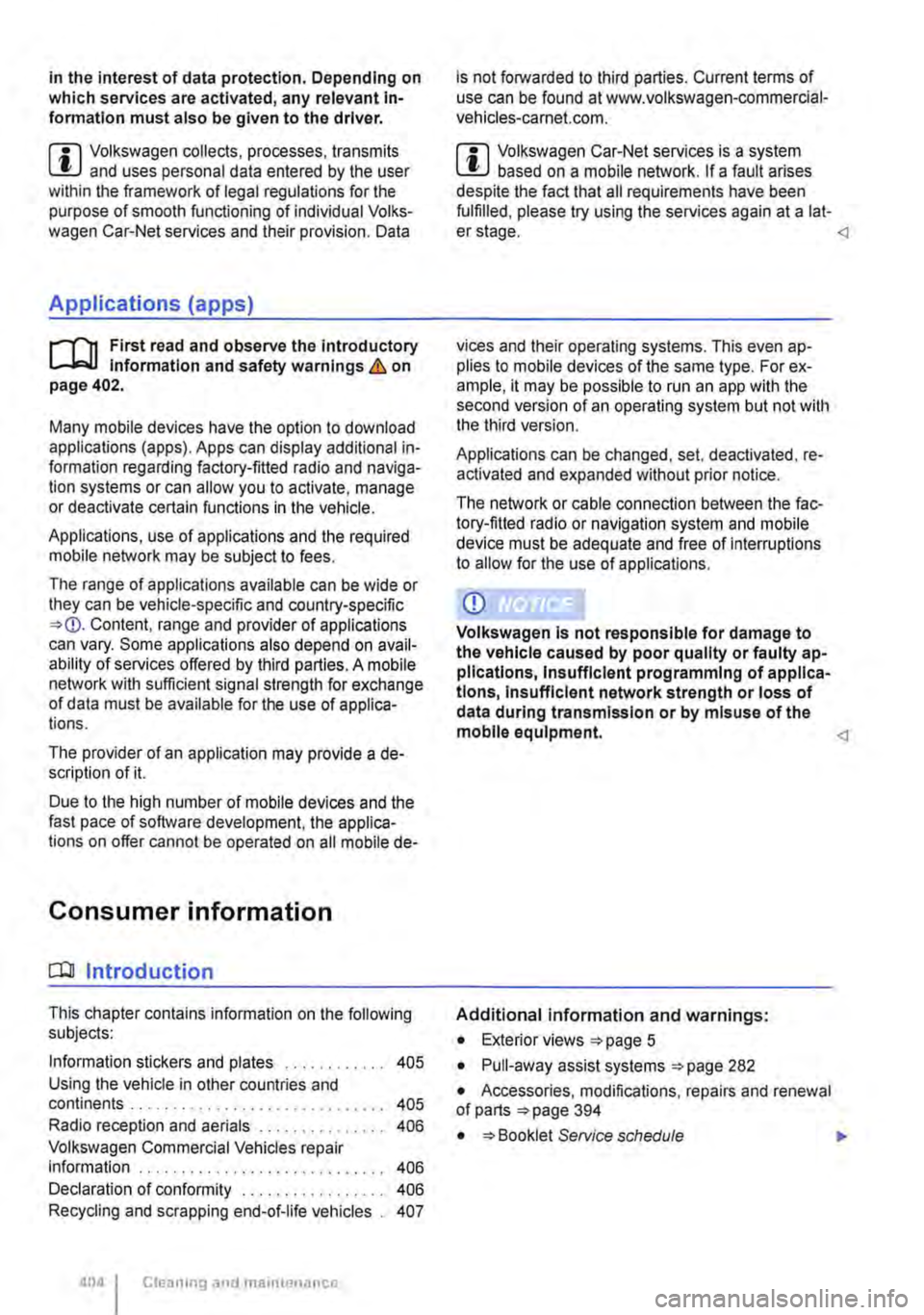
In the interest of data protection. Depending on which services are activated, any relevant In-formation must also be given to the driver.
m Volkswagen collects, processes, transmits W and uses personal data entered by the user within the framework of legal regulations for the purpose of smooth functioning of individual Volks-wagen Car-Net services and their provision. Data
Applications (apps)
r""('n First read and observe the Introductory 1....-J,:.lJ Information and safety warnings & on page 402.
Many mobile devices have the option to download applications (apps). Apps can display additional in-formation regarding factory-fitted radio and naviga-tion systems or can allow you to activate, manage or deactivate certain functions in the vehicle.
Applications, use of applications and the required mobile network may be subject to fees.
The range of applications available can be wide or they can be vehicle-specific and country-specific =>CD. Content, range and provider of applications can vary. Some applications also depend on avail-ability of services offered by third parties. A mobile network with sufficient signal strength for exchange of data must be available for the use of applica-tions.
The provider of an application may provide a de-scription of it.
Due to the high number of mobile devices and the fast pace of software development, the applica-tions on offer cannot be operated on all mobile de-
Consumer information
CQJ Introduction
This chapter contains information on the following subjects:
Information stickers and plates . . . . . . . . . . . . 405 Using the vehicle in other countries and continents . . . . . . . . . . . . . . . . . . . . . . . . . . 405 Radio reception and aerials . . . . . . . . 406 Volkswagen Commercial Vehicles repair information . . . . . . . . . . . . . . . . . . . . 406
Declaration of conformity 406 Recycling and scrapping end-of-life vehicles . 407
404 Cleaning and maintenance
is not forwarded to third parties. Current terms of use can be found at www.volkswagen-commercial-vehicles-carnet.com.
m Volkswagen Car-Net services is a system W based on a mobile network. If a fault arises despite the fact that all requirements have been fulfilled, please try using the services again at a lat-er stage.
Applications can be changed, set, deactivated, re-activated and expanded without prior notice.
The network or cable connection between the fac-tory-fitted radio or navigation system and mobile device must be adequate and free of interruptions to allow for the use of applications.
Q)
Volkswagen Is not responsible for damage to the vehicle caused by poor quality or faulty ap-plications, Insufficient programming of applica-tions, Insufficient network strength or loss of data during transmission or by misuse of the mobile equipment.
• Exterior views =>page 5
• Pull-away assist systems =>page 282
• Accessories, modifications, repairs and renewal of parts =>page 394
• =>Booklet Service schedule .,.
Page 470 of 486
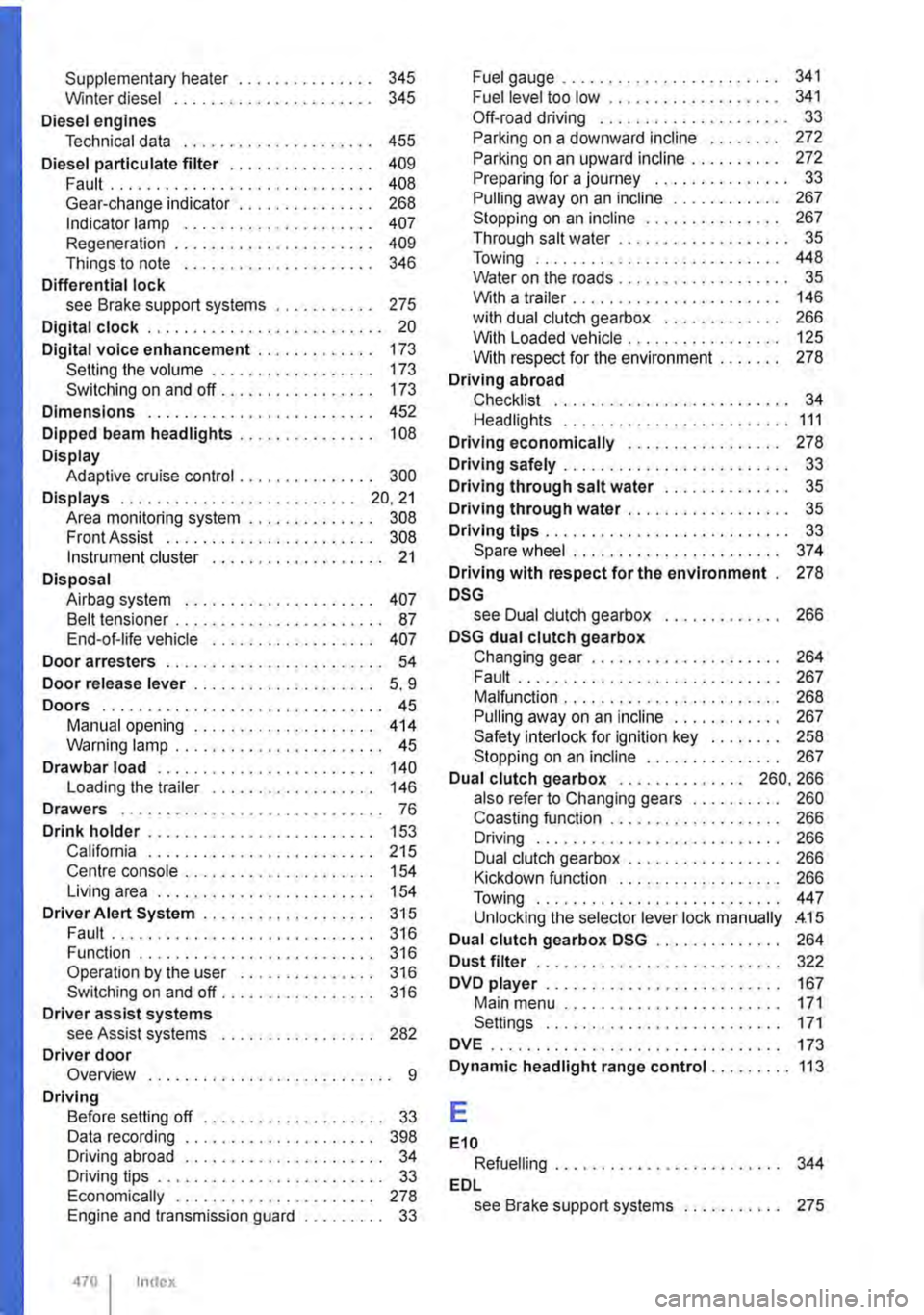
Supplementary heater . . . . . . • . . . . . . . . 345 Winter diesel . . . . . . . . . . . . . . . . . . . . . . 345
Diesel engines Technical data . . . . . . . . . . . • . . . . . . . . . 455
Diesel partlcutate filter . . . . . . • . . . . . . . . . 409 ............................. 408 Gear-change indicator . . . . . . . . . . . . . . . 268 Indicator lamp . . . . . . . . . . . • . . . . . . . . . 407 Regeneration . . . . . . . . . . . . . . . . . . . . . . 409 Things to note . . . . . . . . . . . . . . . . . . . . . 346
Differential lock see Brake support systems . . . . . . . . . . . 275
Digital clock . . . . . . . . . . . . . . . . . . . . . . . . . . 20
Digital voice enhancement . . . . . . . . . . . . . 173 Setting the volume . . . . . . . . • . . • . . . . . . 173 Switching on and off . . . . . . . . . . . . . . . . . 173
Dimensions . . . . . . . . . . . . . . . . . . . . . . . . . 452
Dipped beam headlights . . . . . . . . . . . . . . . 108
Display Adaptive cruise control . . . . . . . . . . . . . . . 300
Displays . . . . . . . . . . . . . . . . . . . . . . . . . . 20, 21 Area monitoring system . . . . . . . . . . . . . . 308 Front Assist .. .. .. .. .. .. .. .. .. . .. .. 308 Instrument cluster . . . . . . . . . . . . . . . . . . . 21
Disposal Airbag system . . . . . . . . . . . . . . . . . . . . . 407 Belt tensioner . . . . . . . . . . . . • . . . . . . . . . . 87 End-of-life vehicle . . . . . . . . . . . . . . . . . . 407
Door arresters . . . . . . . . . . . . . . . . . . . . . . . . 54
Door release lever . . . . . . . . . . . . . . . . . . . . 5, 9
Doors .................•............. 45 Manual opening . . . . . . . . . . . . . . . . . . . . 414 Warning lamp . . . . . . . . . • . . . . . • . . . . . . . 45
Drawbar load . . . . . . . . . . . . . . . . . . . . . . . . 140 Loading the trailer . . . . . . . . • . . . . . . . . . 146
Drawers .....................•....... 76
Drink holder . . . . . . . . . . . . . . . . . . . . . • . . . 153 California . . . . . . . . . • . . • . . . . . . . . • . . . 215 Centre console . . . . . . . . . . . . . . . . . . . . . 154 Living area . . . . . . . . . . . . . . . . . . . . . . . . 154
Driver Alert System . . . . . . . . . . . . . . . . . . . 315 Fault . . . . . . . . . . . . . . . . • . . . . . . . . • . . . 316 Function . . . . . . . . . . . . . • . . . . . • . . • . . . 316 Operation by the user . . • . . . . . . . . • . . . 316 Switching on and off........ . . . . . . . . . 316
Driver assist systems see Assist systems . . . . . . . . . . . . . . . . . 282 Driver door Overview ........................... 9
Driving Before setting off . . . . . . . . . . . . . . . . . . . . 33 Data recording . . . . . . . . . . . . . . . . . . . . . 398 Driving abroad . . . • . . . . . . . . . . . . . . . . . . 34 Driving tips . . . . . . . . . . . . . . . . . . . . . . . . . 33 Economically . . . . . . . . . . . . . . . . . . . . . . 278 Engine and transmission guard . . . . . . . . . 33
470 I Index
Fuel gauge . . . . . . . . . . . . . . . . . . . . . . . . 341 Fuel level too low . . . . . . . . . . . . . . . . . . . 341 Off-road driving . . . . . . . . . . . . . . . . . . . . . 33 Parking on a downward incline . . . . . . . . 272 Parking on an upward incline . . . . . . . . . . 272 Preparing for a journey . . . . . . . . . . . . . . . 33 Pulling away on an incline . . . . . . . . . . . . 267 Stopping on an incline . . . . . . . . . . . . . . . 267 Through salt water . . . . . . . . . . . . . . . . . . . 35 Towing ........................... 448 Water on the roads . . . . . . . . . . . • . . . . . . . 35 With a trailer . . . . . . . . . . . . . . . . . . . . . . . 146 with dual clutch gearbox . . . . . . . . . . . . . 266 With Loaded vehicle . . . . . . . . . . . . . . . . . 125 With respect for the environment . . . . . . . 278
Driving abroad Checklist . . . . . . . . . . . . . . . . . . . . . . . . . . 34 Headlights . . . . . . . . . . . . . . . . . • . . • . . . . 111
Driving economically . . . . . . . . . . . . . . . . . 278
Driving safely . . . . . . . . . . . . . . . . . . . . . . . . . 33
Driving through salt water . . . . . . . . . . . . . . 35
Driving through water . . . . . . . . . . • . . . . . . . 35
Driving tips . . . . . . . . . . . . . . . . . . . . . . . . . . . 33 Spare wheel . . . . . . . . . . . . . . . . . . . . . . . 374
Driving with respect for the environment . 278
DSG see Dual clutch gearbox . . . • . . • . . . . . . 266
DSG dual clutch gearbox Changing gear . . . . . . . . . . . . . . . . . . . . . 264 Fault . . . . . . . . . . . . . . . . . . . . . . . . . . . . . 267 Malfunction . . . . . . . . . . . . . . . . . . . . . . . . 268 Pulling away on an incline . . . . . . . . . . . . 267 Safety interlock for ignition key . . . . . . . . 258 Stopping on an incline . . . . . . . . . . . . . . . 267
Dual clutch gearbox . . . . . . . . . . . . . . 260, 266 also refer to Changing gears . . . . . . . . . . 260 Coasting function . . . . . . . . . . . . . . . . . . . 266 Driving . . . . . . . . . . . . . . . . . • . . . . . . . . . 266 Dual clutch gearbox . . . . . . . . . . . . . . . . . 266 Kickdown function . . . . . . . . . . . . . . . . . . 266 Towing ........................... 447 Unlocking the selector lever lock manually .4.15
Dual clutch gearbox DSG . . . . . . . . . . . . . . 264
Dust filter . . . . . . . . . . . . . . . . . . . . . . . . . . . 322
DVD player . . . . . . . . • . . • . . . . . . . . . . . . . . 167 Main menu . . . . . . . . . • . . • . . . . . . . . . . . 171 Settings . . . . . . . . . . . . . . . . . . . . . . . . . . 171
DVE ................................ 173
Dynamic headlight range control .....•... 113
E
E10 Refuelling . . . . . . . . . . . . . . . . . . . • . . . . . 344 EDL see Brake support systems . . . . . . . . . . . 275